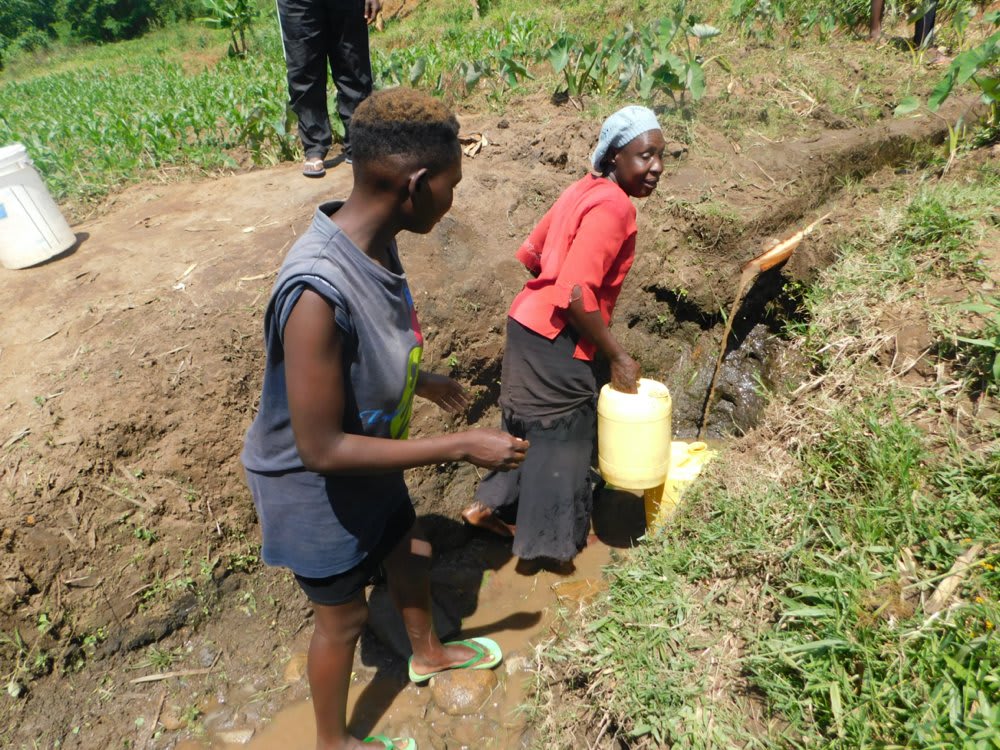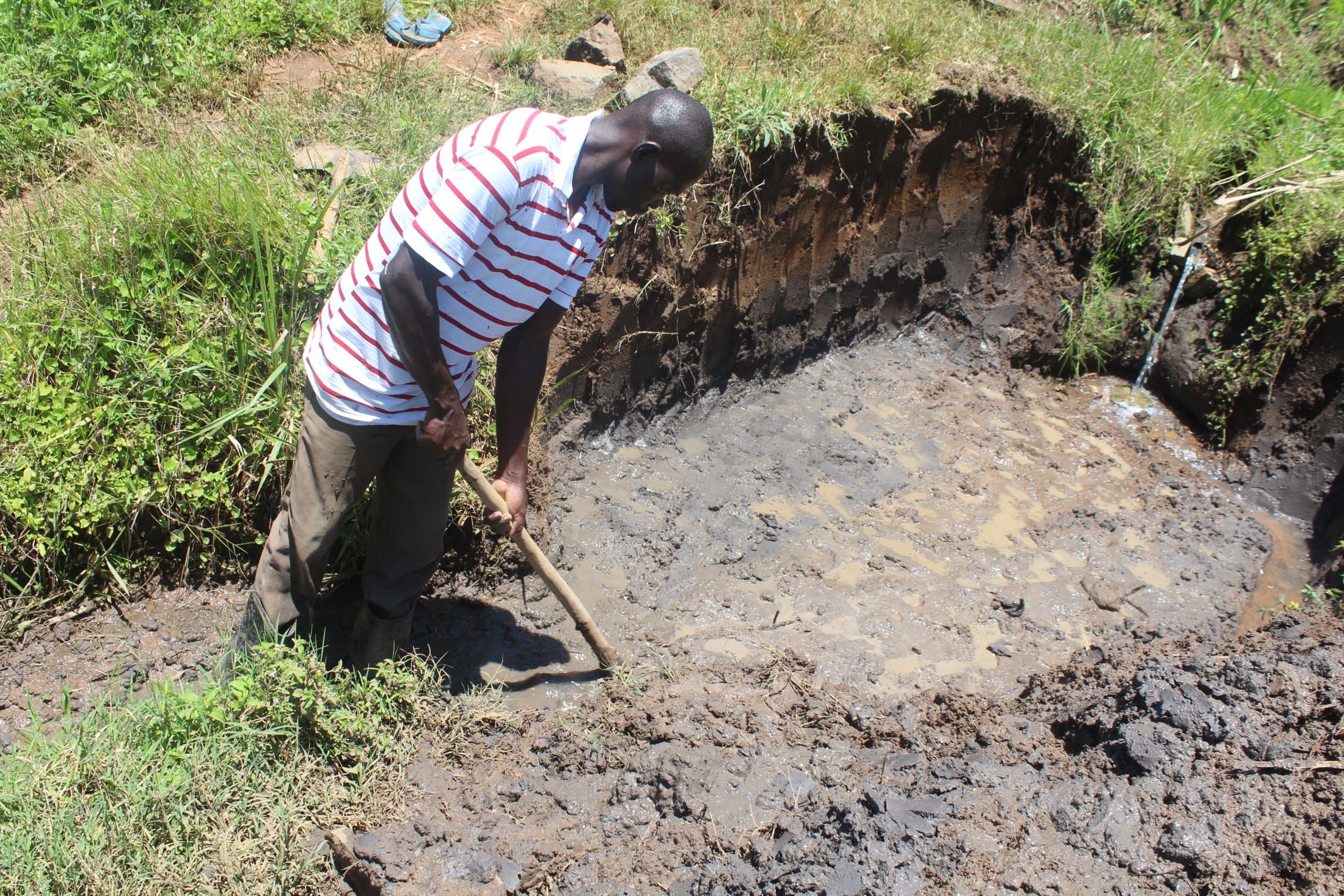Please note: original photos were taken before the COVID-19 pandemic.
Mulukobha Village is saturated with green vegetation; the community is known for its unique skills in agriculture. Accordingly, most people work as farmers, though there are some people who run small businesses or work for others.
Farm plots lead up to Omusebe Spring, which serves 250 people in Mulukobha. Although the spring is reliable and produces water year-round, its accessibility and contamination pose big challenges to community members here.
The area leading up to the spring is carved several feet below ground level into the mud, with a narrow entryway to the access point. The ground here is slick with mud due to the spring's constant output. Community members placed a few stones in this area to try to help themselves avoid the mud, but these, too, are slippery and unstable.
In an effort to improve the spring's discharge and community members' ease of access, they also dug a small trench from the spring's source and installed a long banana stem to help direct the water into a spout, under which people can place their jerrycans. But even the slightest adjustment of the stem, or of the ground upstream from it, can instantly turn the water dark brown with silt. This forces people to wait even longer while the dirt settles so they can once again fetch water.

Rains, too, turn the water brown with eroded soil. But even when the water looks clear, contaminants ranging from farm chemicals to animal waste pollute the water. Sometimes the pollutants are visible, too.
"Sometimes I have seen worms in the water. This caused me to fear drinking the water directly from the spring. It is not comfortable to draw the water from the spring, either," recalled 20-year-old Newton Masai.
"The water is open and anybody with ill intention can easily contaminate the water," said 35-year-old farmer Mildred Omusebe.
"We are afraid to drink the water directly from the spring; we have to boil the water to be sure of its safety."
But boiling requires firewood, which is already difficult enough and time-consuming to collect for cooking. So most people do without any treatment of the spring water, leading to water-related illnesses and their expensive treatment. Time, money, and energy lost when sick robs children of time in class and adults of their productive hours at home, on the farm, and at work.
What We Can Do:
Spring Protection
Protecting the spring will help provide access to cleaner and safer water and reduce the time people have to spend to fetch it. Construction will keep surface runoff and other contaminants out of the water. With the community’s high involvement in the process, there should be a good sense of responsibility and ownership for the new clean water source.
Fetching water is a task predominantly carried out by women and young girls. Protecting the spring and offering training and support will, therefore, help empower the female members of the community by freeing up more of their time and energy to engage and invest in income-generating activities and their education.
Training on Health, Hygiene, COVID-19, and More
To hold trainings during the pandemic, we work closely with both community leaders and the local government to approve small groups to attend training. We ask community leaders to invite a select yet representative group of people to attend training who will then act as ambassadors to the rest of the community to share what they learn. We also communicate our expectations of physical distancing and wearing masks for all who choose to attend.
The training will focus on improved hygiene, health, and sanitation habits in this community. We will also have a dedicated session on COVID-19 symptoms, transmission routes, and prevention best practices.
With the community’s input, we will identify key leverage points where they can alter their practices at the personal, household, and community levels to affect change. This training will help to ensure participants have the knowledge they need about healthy practices and their importance to make the most of their water point as soon as water is flowing.
Our team of facilitators will use a variety of methods to train community members. Some of these methods include participatory hygiene and sanitation transformation, asset-based community development, group discussions, handouts, and demonstrations at the spring.
One of the most important issues we plan to cover is the handling, storage, and treatment of water. Having a clean water source will be extremely helpful, but it is useless if water gets contaminated by the time it is consumed. We and the community strongly believe that all of these components will work together to improve living standards here, which will help to unlock the potential for these community members to live better, healthier lives.
We will then conduct a small series of follow-up trainings before transitioning to our regularly scheduled support visits throughout the year.
Training will result in the formation of a water user committee, elected by their peers, that will oversee the operations and maintenance of the spring. The committee will enforce proper behavior around the spring and delegate tasks that will help preserve the site, such as building a fence and digging proper drainage channels. The fence will keep out destructive animals and unwanted waste, and the drainage will keep the area’s mosquito population at a minimum.

 Protected Spring
Protected Spring
 Rehabilitation Project
Rehabilitation Project





































